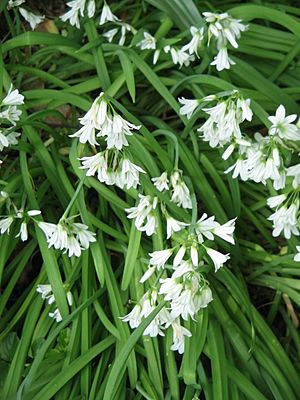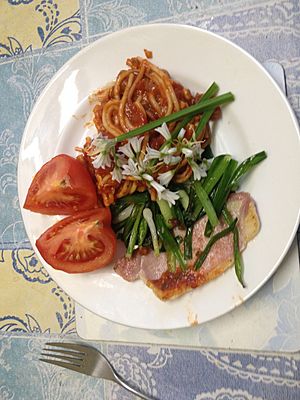Three-cornered leek facts for kids
Quick facts for kids Three-cornered leek |
|
|---|---|
 |
|
| Conservation status | |
| Scientific classification | |
| Synonyms | |
|
The Three-cornered leek (scientific name: Allium triquetrum) is a type of flowering plant. It grows from a bulb, much like an onion or garlic. This plant belongs to the Allium family, which includes all onions and garlic.
It originally comes from the Mediterranean region. This area includes countries around the Mediterranean Sea. People in English-speaking countries also call it "onion weed." Both its English name and its scientific name, triquetrum, describe its unique shape. The flower stalks have three distinct corners.
Where It Grows
The Three-cornered leek is naturally found in southwestern Europe and northwestern Africa. It also grows on the Madeira Islands and the Canary Islands. You can spot it in many places, like open fields, sunny spots in forests, and along riverbanks. It also grows on the sides of roads. It can be found from sea level up to about 850 meters (2,789 feet) high.
This plant has also spread to other parts of the world. It was brought to the British Isles, New Zealand, Turkey, Australia, California, Oregon, and South America. In some of these new places, it grows so well that it is considered a noxious weed. This means it can harm local plants and ecosystems.
What It Looks Like
The Three-cornered leek grows stems that are usually 17 to 60 centimeters (7 to 24 inches) tall. These stems have a special shape; they are triangular and curve inwards. Each stem produces a cluster of flowers, called an umbel. This cluster has between 4 and 19 flowers. They usually bloom from January to May in their native home.
The flowers have white petals, called tepals, which are 10 to 18 millimeters (about 0.4 to 0.7 inches) long. Each petal has a clear green stripe down the middle. The plant also has two or three long, thin leaves. Each leaf can grow up to 15 centimeters (6 inches) long. If you crush the leaves, they smell just like an onion!
Culinary Uses
Good news for food lovers: all parts of the Three-cornered leek are edible! You can eat the bulb, the stems, the leaves, and even the flowers. They can be eaten fresh, for example, in pesto. You can also cook them. They have a mild taste, similar to a leek or a spring onion.
Images for kids
See also
 In Spanish: Lágrimas de la virgen para niños
In Spanish: Lágrimas de la virgen para niños




